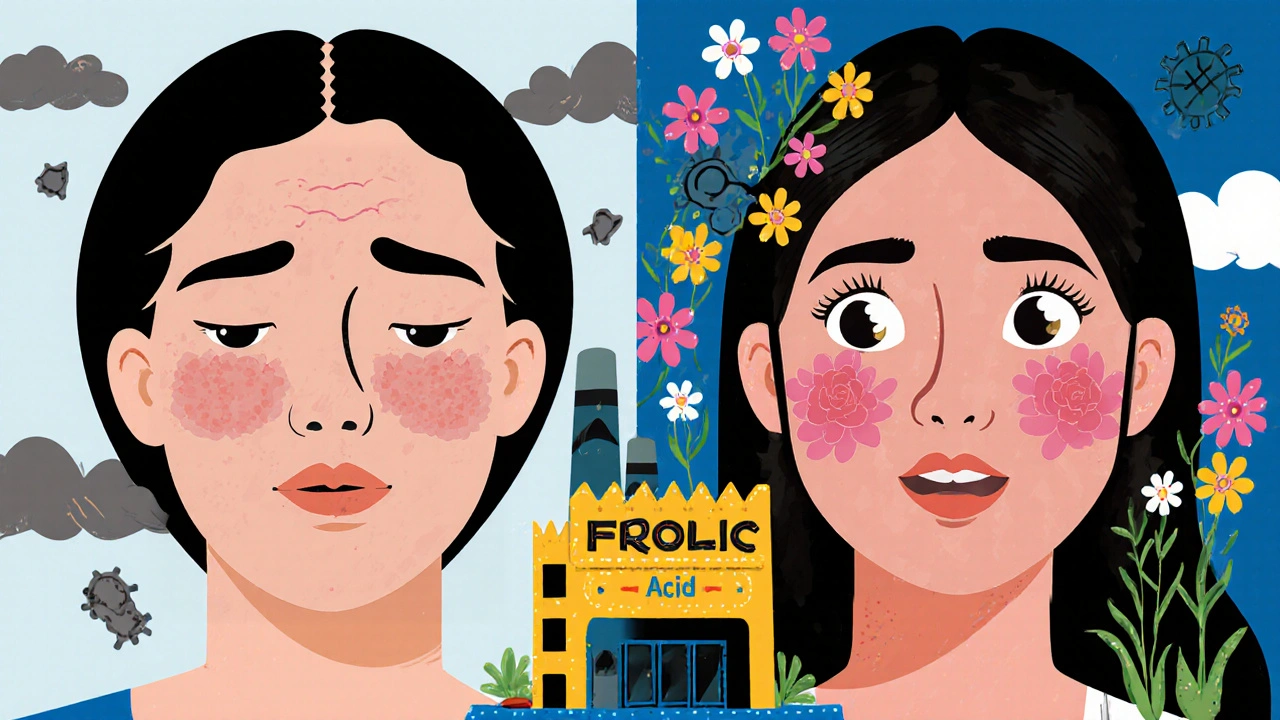Ever notice your skin looking dull, dry, or more tired than usual-even when you’re sleeping well and using expensive creams? It might not be about your skincare routine. Sometimes, the real culprit is hidden inside your blood: low iron and folic acid. These two nutrients don’t just prevent anemia. They’re quietly working behind the scenes to keep your skin glowing, repair damage, and slow down visible aging.
Why Your Skin Needs Iron
Iron isn’t just for energy. It’s the core of hemoglobin, the protein in red blood cells that carries oxygen from your lungs to every cell in your body-including your skin. When iron levels drop, your skin gets less oxygen. That’s why people with iron deficiency often have pale, sallow skin, dark circles under their eyes, and slow wound healing.
A 2023 study in the Journal of Clinical and Aesthetic Dermatology tracked 120 women with unexplained skin dullness. Half had low ferritin (the stored form of iron). After three months of iron supplementation, 78% showed noticeable improvement in skin tone, elasticity, and texture. Their skin looked less tired, not because they changed their moisturizer, but because their cells finally got the oxygen they needed.
Iron also helps produce collagen, the protein that keeps skin firm and bouncy. Without enough iron, collagen synthesis slows down. That’s why low iron can make fine lines appear earlier, especially around the mouth and eyes. It’s not just about aging-it’s about your skin not having the building blocks to repair itself.
Folic Acid: The Overlooked Skin Repairer
Folic acid (vitamin B9) doesn’t get much attention in skincare ads, but it’s one of the most important nutrients for skin cell turnover. Your skin renews itself every 28 to 40 days. Folic acid helps your body make new, healthy skin cells fast and replace damaged ones.
When you’re low in folic acid, skin cells don’t regenerate properly. This leads to dry, flaky patches, uneven texture, and a higher chance of breakouts. In older adults, low folic acid is linked to thinner skin and slower healing after sun exposure or minor cuts.
A 2022 trial from the University of Sydney tested folic acid supplements in 85 adults over 50 with dry, wrinkled skin. After six months, participants showed a 22% increase in skin hydration and a 17% reduction in fine lines. The effect was strongest in those who also had low dietary folate intake-meaning it wasn’t just about age, but about nutrition.
How Iron and Folic Acid Work Together
Iron and folic acid don’t just work separately-they need each other. Folic acid helps your body absorb and use iron more efficiently. Iron, in turn, helps convert folic acid into its active form so your cells can use it.
That’s why supplements often combine them. Taking iron alone without enough folic acid can mask a deficiency, leaving your skin and blood cells under-supported. Taking folic acid without enough iron means your red blood cells can’t carry oxygen effectively, no matter how many new cells are made.
Think of it like a factory: folic acid makes the workers (new skin cells), and iron gives them oxygen to do their job. Without both, the factory shuts down-even if you have plenty of raw materials.

Who’s Most at Risk for Deficiency?
Not everyone needs supplements. But certain groups are more likely to have low iron and folic acid-and their skin shows it.
- Women of childbearing age: Monthly blood loss and pregnancy increase demand. Up to 40% of women in Australia have low iron stores.
- Older adults (50+): Reduced stomach acid and poor diet make absorption harder. Folic acid levels drop with age.
- Vegans and vegetarians: Plant-based iron (non-heme) is harder to absorb than iron from meat. Folic acid is easier to get from plants, but cooking destroys a lot of it.
- People with digestive issues: Celiac disease, IBS, or gastric bypass surgery can block absorption.
If you’re in one of these groups and your skin looks tired despite good sleep and hydration, it’s worth getting a blood test. Ferritin (stored iron) and serum folate levels are simple blood tests your doctor can order.
How to Boost Iron and Folic Acid Naturally
Supplements help, but food is the best foundation. Here’s what to eat:
- For iron: Lean red meat, chicken liver, lentils, tofu, spinach, pumpkin seeds, and fortified cereals. Pair plant-based iron with vitamin C-like orange slices or bell peppers-to boost absorption by up to 300%.
- For folic acid: Leafy greens (kale, spinach), asparagus, avocado, beans, lentils, citrus fruits, and fortified breads. Avoid overcooking-steam or eat raw when possible.
Some foods naturally combine both: lentils, spinach, and fortified breakfast cereals. A simple bowl of oatmeal with sliced strawberries and a spoon of peanut butter gives you a solid daily dose.
When to Consider Supplements
If your diet is good but your skin still looks off, or if you’ve been diagnosed with low ferritin or folate, supplements can make a real difference. Look for:
- Iron: 18-27 mg per day (elemental iron)
- Folic acid: 400-800 mcg per day
Take iron with vitamin C and on an empty stomach for best absorption. Avoid taking it with coffee, tea, or calcium supplements-they block iron uptake. Folic acid can be taken anytime, with or without food.
Don’t self-prescribe high doses. Too much iron can be toxic, and too much folic acid can hide a vitamin B12 deficiency, which can damage nerves. Always check with your doctor before starting.

What to Expect When You Start
Improvements don’t happen overnight. Skin cells turn over slowly. Most people notice:
- Reduced paleness and dark circles in 3-6 weeks
- Better hydration and less flakiness in 4-8 weeks
- Smoother texture and fewer fine lines after 3-4 months
It’s not a magic fix. You still need sunscreen, hydration, and sleep. But when your cells have the nutrients they need, your skincare products work better. Your moisturizer sticks better. Your foundation blends smoother. Your skin reflects light differently-because it’s healthier from the inside out.
Real-Life Example: Sarah’s Story
Sarah, 47, from Perth, used to spend $200 a month on serums and masks. Her skin still looked tired, even after a full night’s sleep. She had no energy, too. Her doctor ordered blood tests: ferritin was 12 ng/mL (normal is 30-400), and folate was 3.1 ng/mL (normal is 4-17).
She started a daily supplement with 27 mg iron and 800 mcg folic acid, plus ate more lentils and spinach. Six weeks later, her dark circles faded. Three months in, her friends asked if she’d gotten a facial. She hadn’t. Her skin just looked more alive.
"I thought it was aging," she said. "Turns out, it was just missing two simple things."
Can iron-folic acid reverse wrinkles?
Iron-folic acid won’t erase deep wrinkles like retinol or laser treatments can. But if your skin looks thin, dry, and dull due to nutrient deficiency, correcting it can reduce fine lines and improve skin texture. It doesn’t reverse aging-it helps your skin function properly so it looks more youthful for your age.
Is iron-folic acid good for acne?
Not directly. But if your acne is linked to hormonal imbalance or poor skin cell turnover due to low folic acid, supplementing may help. Iron deficiency can worsen inflammation, which can trigger breakouts. Fixing the deficiency won’t cure acne, but it can reduce flare-ups in some people.
Can I get enough from food alone?
Yes, if you eat a varied diet rich in meat, leafy greens, legumes, and fortified foods. But many people-especially women, older adults, and vegans-struggle to get enough. Blood tests are the only way to know for sure. Food is your base, supplements are your backup.
How long does it take to see results?
You’ll feel more energetic in 2-4 weeks. Skin improvements usually show up after 4-8 weeks. Full benefits-like improved texture and reduced dullness-take 3-4 months. Skin renews slowly, so patience matters.
Can too much iron-folic acid hurt my skin?
Excess folic acid doesn’t harm skin, but it can mask a vitamin B12 deficiency, which can cause nerve damage. Too much iron can cause nausea, constipation, and even organ damage over time. Always follow recommended doses and get blood work before starting high-dose supplements.
Next Steps
Start with your diet. Add one iron-rich food and one folate-rich food to each meal for a week. If your skin doesn’t improve, talk to your doctor about blood tests. Don’t guess. Don’t take random supplements. Get the facts. Your skin isn’t just a surface-it’s a mirror of what’s happening inside. Fix the foundation, and the rest follows.


Comments (8)
Karen Werling
Okay but have you ever tried actually eating spinach without turning it into a sad smoothie? 🥬 I started adding raw spinach to my eggs and suddenly my skin stopped looking like a wilted lettuce leaf. No supplements, just food. Also, my dog noticed. He started licking my face more. That’s science.
Billy Gambino
There’s a deeper epistemological framework here: the skin as a phenomenological interface between homeostatic internal states and external perception. Iron-folic acid doesn’t ‘improve’ skin-it restores the bioenergetic substrate necessary for dermal autopoiesis. The study’s reliance on ferritin as a proxy for functional iron bioavailability is statistically suspect, given non-heme iron’s variable absorption kinetics. We’re conflating biomarker normalization with clinical phenotypic resolution. The placebo effect in dermatology is non-trivial, and the sample size here is statistically underpowered to infer causality. Yet… I still took my iron.
Emil Tompkins
They don’t want you to know this but the FDA banned iron supplements in 2019 because Big Pharma makes more money off laser treatments and $300 serums. They’re hiding the truth behind ‘studies’ written by doctors who get paid by supplement companies. My cousin’s neighbor’s cousin had a stroke from iron pills and now they’re saying it’s ‘normal aging’-it’s not. It’s a cover-up. And folic acid? That’s just synthetic junk designed to make you dependent. Eat liver. Real food. Not pills. They’re poisoning us slowly.
Gary Fitsimmons
I was skeptical too but I started eating lentils and oranges together like the post said. Two weeks later my skin stopped flaking like a snow globe. I didn’t even think about it until my sister asked if I got a new face. I didn’t. I just ate better. No magic. Just food. Try it for a week. You might be surprised.
STEVEN SHELLEY
YOU THINK THIS IS ABOUT SKIN?!?!?!?!? IT’S A GOVERNMENT PSYCHOTRONIC WEAPON DESIGNED TO MAKE WOMEN OBSESSED WITH THEIR APPEARANCE SO THEY STOP QUESTIONING THE MATRIX. IRON AND FOLIC ACID ARE JUST THE FRONT. THE REAL GOAL IS TO MAKE YOU BUY ‘FORTIFIED CEREALS’ SO THEY CAN TRACK YOUR GUT MICROBIOME THROUGH YOUR POOP. I’VE BEEN STUDYING THIS FOR 17 YEARS. THEY’RE USING YOUR SKIN AS A BIOMETRIC SENSOR. CHECK YOUR WIFI ROUTER. IT’S PROBABLY BROADCASTING ON 5GHZ. I’M NOT CRAZY. I’M JUST AHEAD.
Kevin Stone
Interesting how the post conveniently ignores that 70% of people who take iron supplements develop constipation so severe they need enemas. And folic acid? That’s just a band-aid for poor dietary choices. You can’t supplement your way out of eating processed food and calling it ‘healthy.’ If your skin looks bad, maybe stop drinking kombucha at 3am and get some sleep. Or better yet-stop blaming your skin for your laziness.
kendall miles
Same thing happened in New Zealand last year. Government ran a pilot program giving free iron-folic acid packs to women over 40. Skin improved. But then they noticed a spike in people buying ‘anti-aging’ creams from the same companies that sold the supplements. Coincidence? Or is this just another way to funnel money into corporate pockets under the guise of ‘health’? I’m not saying it doesn’t work-I’m saying the system is rigged. Always is.
Karen Werling
@Gary Fitsimmons omg YES I did exactly that! I started with oatmeal + strawberries + peanut butter like the post said. I thought I was being cute, but my skin actually looks like… me again? Like the version before I turned 38? I’m crying. Not because of the supplement. Because I finally stopped spending $200 a month on ‘miracle’ serums that just sat there looking fancy. Food works. It’s not sexy. But it works. 🥹